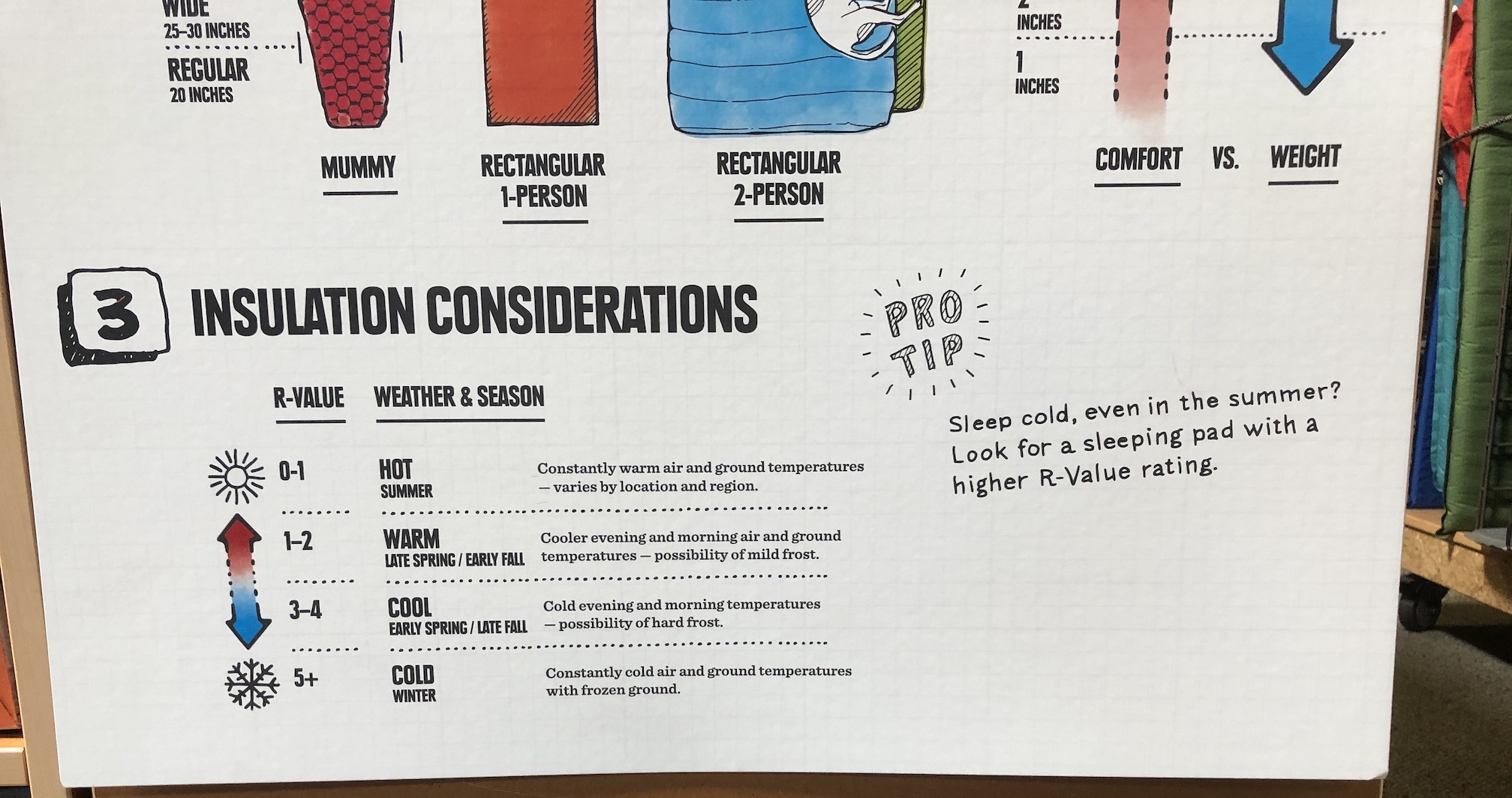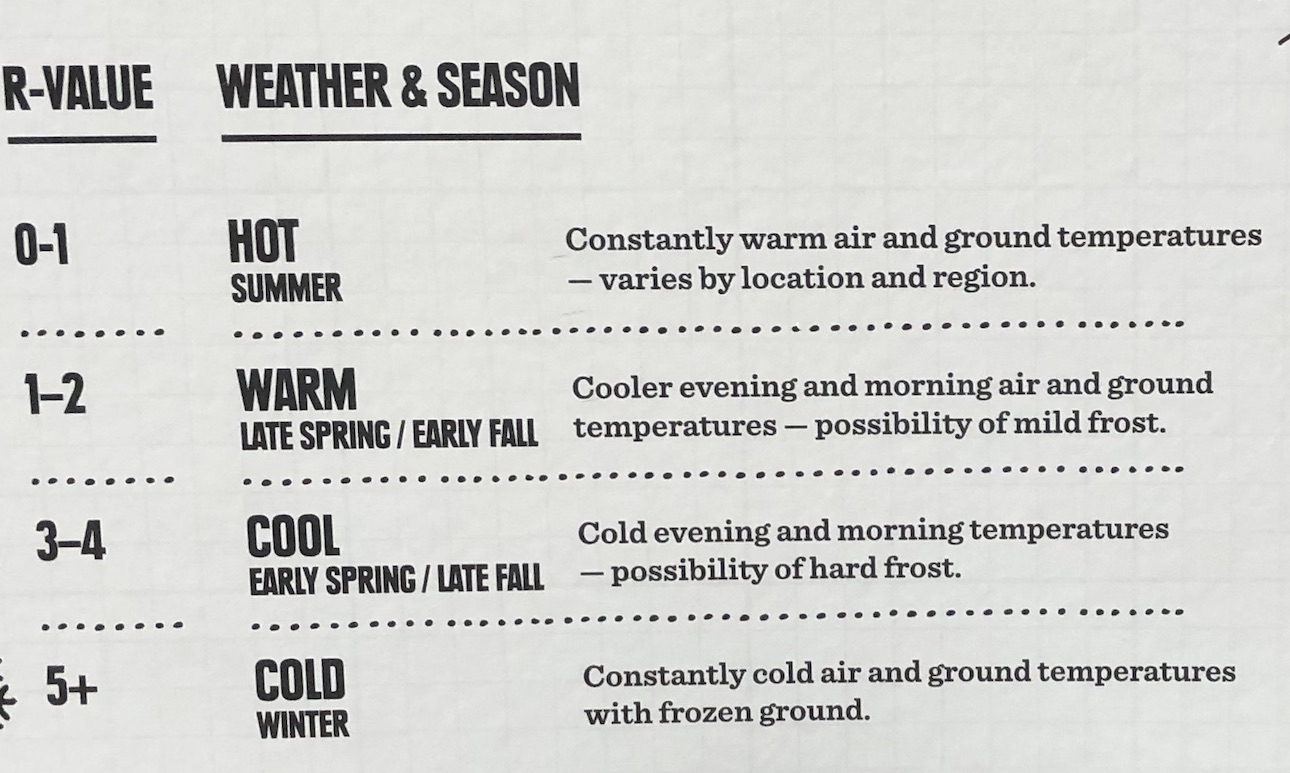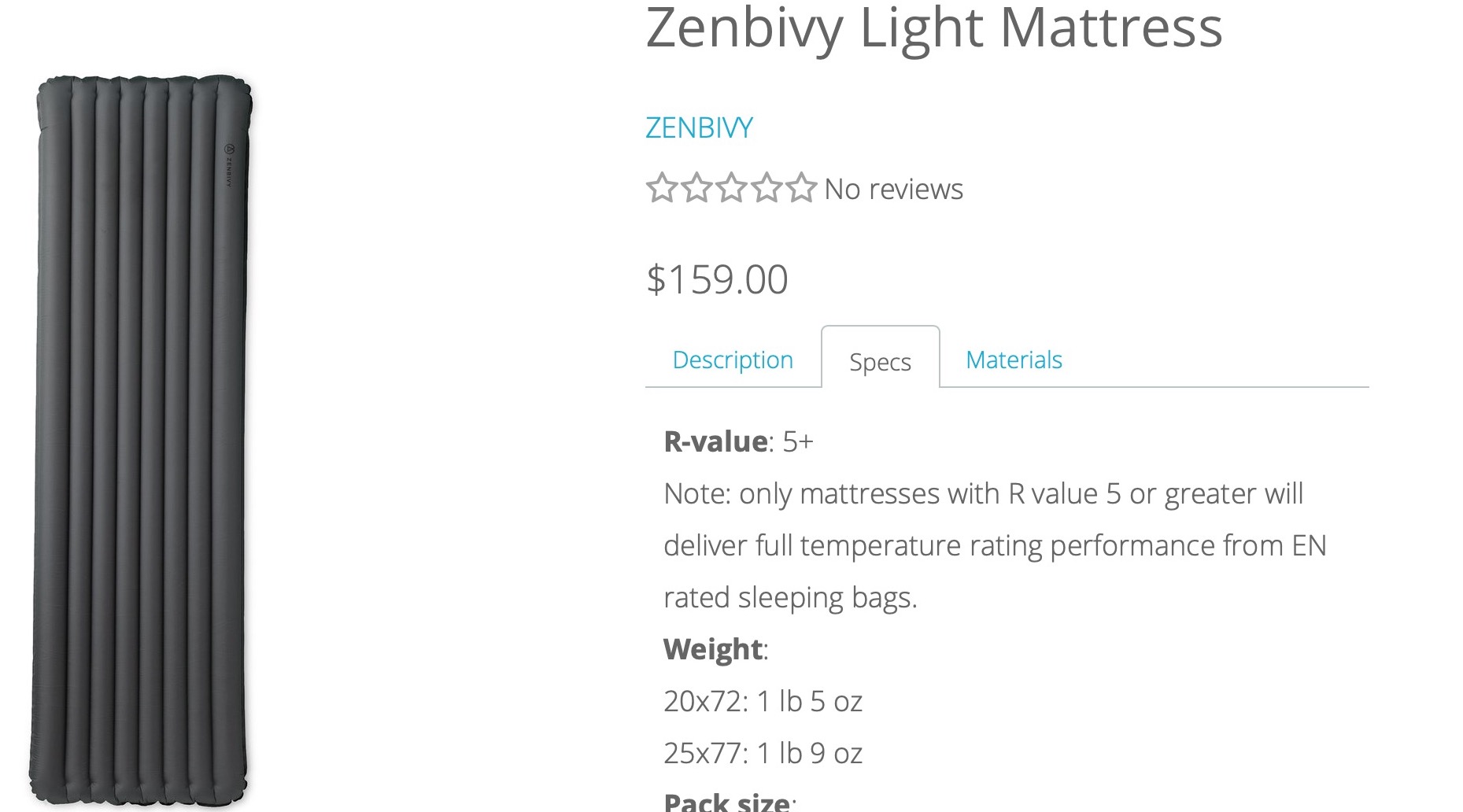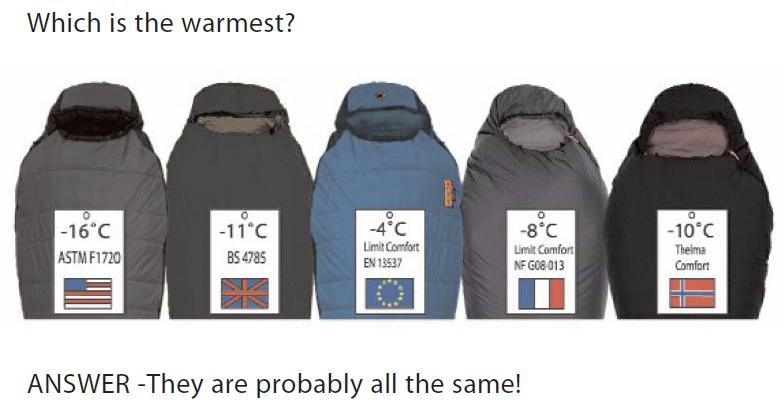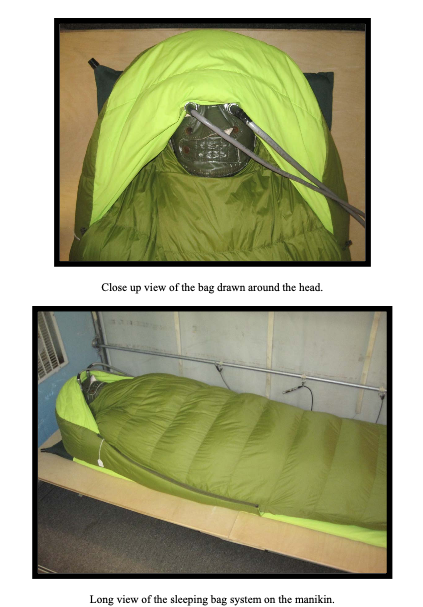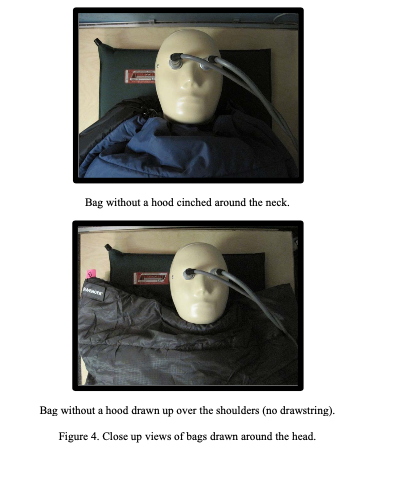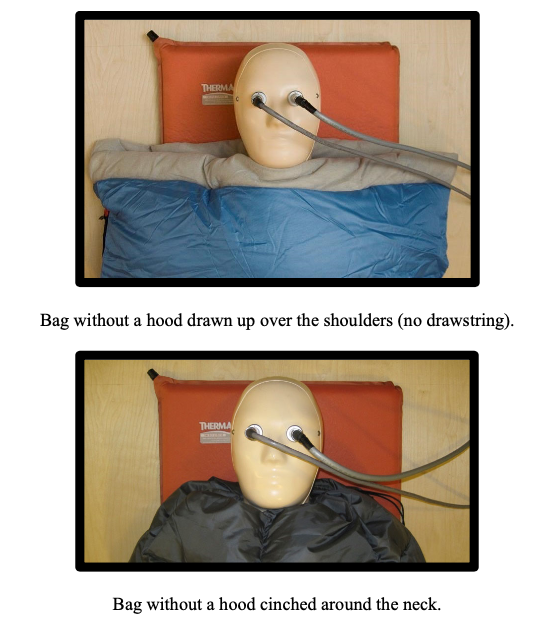Topic
Is Enlightened Equipment temperature rating accurate?
Forum Posting
A Membership is required to post in the forums. Login or become a member to post in the member forums!
Home › Forums › Gear Forums › Gear (General) › Is Enlightened Equipment temperature rating accurate?
- This topic has 102 replies, 33 voices, and was last updated 5 years, 4 months ago by
 James Marco.
James Marco.
-
AuthorPosts
-
Mar 16, 2017 at 1:38 pm #3457180
yeah, you can take it to extremes, but if you have a warmer bag, you can have a thinner pad up to a point
Roger will independently verify : )
Does Richard do that also?
Mar 16, 2017 at 1:43 pm #3457182Yes
Mar 16, 2017 at 2:36 pm #3457189can you do the EN test?
Mar 16, 2017 at 2:55 pm #3457196Anyone with $600 can do the EN test at Kansas State University.
Mar 16, 2017 at 4:14 pm #3457215A lot of good stuff in all these postings.
Michael:
Testing everything with a pad with an R-value of 5 would certainly take the pad out of the equation for most 3-season stuff, so that would be a start. However, since a good Down Air Mat can have an R-value of >9, it might not be sufficient for serious winter gear. That is why I am suggesting going to the extreme for all quilt/SB testing.Now, does the actual value of 5 make sense for all quilt use? I do have a problem with it, as I can well imagine some people sleeping quite happily on a foam mat with an R-value of 1.0 in mid-summer on a thick bed of dry pine needles. The duff can have quite a good R-value by itself. So you would lose some credibility there.
It seems to me that this could end up a no-win situation. Balancing the insulation needs between mat and quilt is technical. How many casual novice customers are going to have a clue what you are talking about – or at that stage even care?
Matt:
the educated consumer might conclude that topping a “simple” air mattress off with a $15 closed celled foam pad is much cheaper and just as thermally efficient as shelling out $150-$200 for the flagship R-5+ mattress.
And the educated consumer would even be right. Yep – problem for the vendor. Of course, you need to look at the total weight, but even that might favor the mat+foam.And don’t forget that the claimed R-value is for the mat fully inflated and not squashed down. Reality is that customers often under-inflate for comfort, and that 75 mm thickness is reduced to 20 mm. Then they don’t understand why they got cold. We covered that very thoroughly in our series on air mats, but there are 2 problems there. First, the mat vendors won’t want to admit that their R5 mat might not be that warm in the field, and second – it’s technical, and beyond the casual novice.
In fact, in a current thread on wet clothing (eVent mitts), one poster wrote
I do not know enough about the technical aspects of clothing, to be honest Bob i don’t care as it doesn’t interest me in the slightest.
So you can see the problem. (Yeah, we’re geeks.)Proper independant testing of quilts and mats is certainly one answer, but the current costs are high. I have some of the test gear, at least enough for mats, but I don’t have a maniken or a conditioned cold room. These things cost $$.
Cheers
Mar 16, 2017 at 9:50 pm #3457297It seems to me that this could end up a no-win situation. Balancing the insulation needs between mat and quilt is technical. How many casual novice customers are going to have a clue what you are talking about – or at that stage even care?
Agree, and it is proven out here every day when folks with less experience ask for help in bag/pad recommendations from real world experience instead of suffering through another miserable referral from a big box outfitter. Test dummies are all the same gender, have all the same metabolisms, they eat the same amount of calories before bedtime, test in the same weather ect. Noobs as we all were once are lucky if they can hash half of this stuff out before getting their first kit together. I sure as hell take mfg’s numbers with more than a grain of salt, EN ratings included. I did my homework the second time around when gearing up for UL and through real world experience passed on to me here and a lot of common sense I developed a kit first time around that needed little tuning. It took some exhaustive efforts of informing myself of all the variables but it did pay off. That’s why I will always have time to help anyone getting started…its just easier when you get a little help from folks that
know betterhave made all the mistakes already :)Mar 17, 2017 at 4:53 am #3457331I recently stumbled over Cumulus (www.cumulus.pl). AFAIK they quote EN ratings. Their 450quilt (with 450 grams of down or 15,87 ounces) is rated to -7 C or 20 F. Size-wise if I interpret the sizing of Cumulus correctly this should correspond to approximately a short/wide from Enlightened Equipment. Enlightened Equipment use about 340 grams or 12 ounces of down in the equal quilt.
To me it seems like EE is a bit overstated than the EN ratings. Makes it harder to compare, I usually compare filling weights. Problem is, I’m new to quilts so I don’t really know what is enough.
Cumulus 450:
- Total weight: 685 g
- Down weight: 450 g
- Weight of unfilled sleeping bag: 235 g
- Comfort temperature: -1 ˚C
- Limit temperature: -7 ˚C
- Maximum user height: 185 cm
- Length: 177 cm
- Width (top/bottom): 77/51 cm
- Stuffsack’s dimensions (height/diameter): 25/17 cm
- Stuffsack’s volume: 5,7 l
- Number of down chambers: 36
Remember “Limit temp” is translated to “mens comfort” under the EN standard.
Mar 17, 2017 at 5:41 am #3457332Cumulus quotes their rating in the same manner as ER but at least up to several months ago they didn’t mention anywhere that they did test according to EN13537.
Mar 17, 2017 at 8:01 am #3457351“In fact, in a current thread on wet clothing (eVent mitts), one poster wrote
I do not know enough about the technical aspects of clothing, to be honest Bob i don’t care as it doesn’t interest me in the slightest.”Wow, just read that thread. I guess I should have figured something rather interesting was going rather than assuming the 70+ posts were about how to seam seal eVent mitts.
Yet not to digress to much, this is about the reliability of EE temp ratings, right? Or, perhaps generically: the consumers desire to “trust” that the specifications they are provided are in-fact “trustworthy”.
;<D
Mar 17, 2017 at 8:38 am #3457359For Sleeping bags, I agree that a pad+SB combo gets very technical. I do the same as Roger described, ie, scraping up forest duff under my pad. Often this is for comfort, but it is also for extra warmth when temps start dropping. I also don’t inflate my pads fully. This is more to prevent future problems with delamination and for comfort.
Using a quilt, however IS technical. It requires a good pad, even in summer. With an Xlite and Nightlite, I believe the combo is around an R5-R6.
I believe that an R5 is good enough for EN testing. Most people won’t care about this though. They will bring a 3/8″ blue foam pad along with a sleeping bag and sort of wonder why they get cold. So, I always say that the comfort limit is the true bags rating. It saves a lot of explaining. Here, we know that is not truly the case.
Sep 29, 2017 at 4:58 pm #3493929I use simple guidelines when it comes to mats/pads. 45F or below I use my Exped Synmat and if gets below 30F I use my Exped Downmat 9. That way I guarantee I am adequately warm from below.
I’ve been in a situation before when I was too cold from not having a appropriately-rated mat. It was a very long night and I promised I’d never let that happen again.
Sep 29, 2017 at 11:37 pm #3494002I happily have 3 EE quilts.
30 deg Rev 800fp
20 deg Rev 850fp
10 deg Engima 850fp
On a scale of 1-10, 1 being and extremely cold sleeper, 5 being average and 10 being very hot, I’m about a 2.5 (cold/coldish). In my experience, the ratings are accurate when used to maximize warmth. Meaning good site selection, no air gaps, and wear base layers and possibly rain pants, beanie and puffy.
In this configuration I am comfortable to 5 deg above the rating so I assume an average sleeper will be comfortable at the temp rating. It does take some experience to maximize the potential of any quilt though. Tim and company out out great quilts!
Sep 30, 2017 at 12:02 am #3494004Don – sorry, but your figures are fairly meaningless by themselves. You have not specified what mat(s) you are using, and it is very clear these days that heat loss through the mat can be greater than heat loss through the quilt.
Are you perhaps a ‘cold’ sleeper because your mats are not good enough?
(This is actually meant to be helpful!)Cheers
Oct 20, 2019 at 1:14 am #3614755Found this sign at my local REI – the same REI that soon will require R-values for sleeping mats, and quotes EN values for sleeping bags based on R 5 mats:


Other pad vendors have similarly misleading and potentially dangerous guidance.
Until manufacturers and sellers start posting notes alongside sleeping bags like “rated temps require an R5 or higher sleeping mat,” and next to wimpy mats like “this mat isn’t warm enough to support sleeping bag temp ratings”, consumers will be mislead.
Not holding my breath.
— Rex
PS: Zenbivy is the only one doing something like that AFAIK:
 Oct 20, 2019 at 2:00 am #3614766
Oct 20, 2019 at 2:00 am #3614766Can someone point me to online documentation that states EN ratings are with an R5 pad?
- I’ve echoed this claim to others on FB before and they didn’t believe me.
Oct 20, 2019 at 4:32 am #3614784Can someone point me to online documentation that states EN ratings are with an R5 pad?
Probably not.
You see, the subject is very complex, with ‘warm’ sleepers, ‘cool’ sleepers, males, females, different metabolisms, different test conditions, different (brand) enthusiasms for the EN Standard, national differences, and so on. In addition, since it is complex, testing to the EN Standard tends to be expensive, which accounts for some commercial reluctance.You will hear comments like ‘Our bags are 5 degrees warmer than brand X, so we label them accordingly’. In addition, it is a well-known FACT that American manufacturers usually claim their bags to be around 16 C better than they measure under the EN Standard. This is a sad reflection on many USA mfrs.
Mammut (Europe) include this pic in one of their tech papers on ratings, using data from their own testing (I think):

So it is not just the American brands which wander.Unfortunately, while the EN Standard is fairly solid in its own way, it does have some ‘less clear’ sections. One of these is the rating or R-value for the mat to be used. They get as far as saying that the mat must be warm enough that further increases will not change the results. I can understand their thinking, and that will be OK for testing, but the spec does not help us (the users) much.
If you read our SoTM on air mats at
https://backpackinglight.com/airmat_sotmr_part1_2011/
https://backpackinglight.com/airmat_sotmr_part2_2011/
you will see that available mats cover a huge range of R-values. But what is missed in the EN Standard and in almost EVERY vendors specs is a mention of how ‘blown up’ the mats is when tested. Quoting from our article about one mat:
When the mat is fully inflated (44 mm thick) the R-value can be as high as 4.5, but when the mat is squashed down to between 14 and 18 mm thick (as it might be under your hips) the R-value is only about 2.0.The problem with a mat which is blown up hard (to get maximum insulation) is that it becomes rather uncomfortable. Much greater comfort is to be had when the mat is deflated a bit, so it conforms more to your body – but then the thickness and the R-value go down.
I measured R-values from 1.0 (empty pool-toy style) to over 15 (down air mat). Note that the R-value of 1.0 is cold under most conditions.
A value of 5, if maintained while you are sleeping on it, should be fine under most conditions not on snow.
HTH
CheersOct 20, 2019 at 12:09 pm #3614801Yeah, I agree, Roger. Bags, quilts and pads are all over the scales. The best you can do is read some good Cold Weather reviews.
The basic pad rating is, in itself, also not quite clear cut. As Roger described, there are regions (under you) that have far less insulation than other areas. CCF, Down or Synthetic fills, underlying ground conditions, metabolism, sleeping position etc, all force difficulties in registering consistent temps…death for any standard. However, a standard IS needed. R5 is the closest to a good 3 season pad covering the wide range of spring/summer/fall conditions. Even that is lacking for late fall/early spring, though.
During UL/SUL seasons, it is rare to mention the difficulties trying to sleep under a too warm quilt/bag. Bugs are out, rodents abound, and midnight pests are numerous. Sleeping in a tent is always too warm. Sleeping under a tarp or other floorless shelter means bugs. DEET and ilk become an essential part of sleeping gear. Quilts and bags are almost painfully warm. Yet, it is common to sleep under them as you cower in fear of the bugs. And, there is nothing to be done about the heat. In cooler weather, you can add layers, in heat you cannot shed more than your skin. The upper comfort range becomes a real thing.
Oct 20, 2019 at 1:35 pm #3614813“Can someone point me to online documentation that states EN ratings are with an R5 pad?”
If I recall, this publication talks about the use of R5 pads for EN fairings. I’m not able to review it right now but enjoy!
https://www.outdoorindustry.org/pdf/EN13537Mccullough062209.pdf
Oct 20, 2019 at 5:41 pm #3614854A word about EE, while I’ve found their quilts comfortable at their lower range wearing baselayers,a hood and their strap system (though I’ll sleep warm after a “hard days hike”), … at a Trail Days EE booth, they’ve mentioned their new quilts are overstuffed plus they’ll overstuff an older quilt.
Oct 20, 2019 at 9:23 pm #3614895As far as I can tell from close reading (I already had that paper), the McCullough paper does not actually cover the R-value of the pad.
I suspect that the writers of the EN Standard were more focused on their manikins than on the pad. Perhaps the full importance of the pad had not yet surfaced at that stage.
Cheers
Oct 21, 2019 at 2:48 am #3614962I think the winding trail from EN Standard through McCullough paper to an R 4.8 pad was covered in this thread a couple of years ago:
https://backpackinglight.com/forums/topic/is-enlightened-equipment-temperature-rating-accurate/page/2/#post-3456918
https://backpackinglight.com/forums/topic/is-enlightened-equipment-temperature-rating-accurate/page/3/#post-3456922Am I missing something?
— Rex
PS – Too bad the EN/ISO standards are behind expensive paywalls, e.g.
https://webstore.ansi.org/Search/Find?in=1&st=ISO+23537
$202 for all the bits and pieces.Oct 21, 2019 at 5:47 am #3614977Yes, Standards organisations seem impelled to charge outrageous amounts for their electronic PDF files.
I do not have a copy of the full Standard myself – for $$ reasons. But you could have this summary for consumers for $0 ……Um – it’s a PDF file and right now I can’t see how to include that! It came from the EuropeanOutdoorGroup, but I can’t find it on their web site either.
Bother
CheersOct 21, 2019 at 11:09 am #3614984Roger, you can use this: https://smallpdf.com/pdf-to-jpg
Oct 22, 2019 at 8:41 pm #3615255Mike Glavin from Zenbivy here. Two thoughts to share:
- The source for the “R5” number is included below for your reference.
- The number does not matter, only the mattress used in the test fixture (and its pressure) really matters. So measuring the fixture mattress is really the only way. Funny, after getting some anomalous results on a test recently, one thing I noticed is that the mattress had changed, and wondered if that could be a factor. Check out the variation in mattress in the enclosed photos (some are Kansas State “stock” images where you can see the logo on the mattress).



Testing Sleeping Bags According to EN 13537:2002: Details That Make the Difference
Kalev Kuklanea & Valter Dejkeb
a Division of Ergonomics and Aerosol Technology, Lund University, Lund, Swedenb Department of Textiles and Plastics, Swerea IVF AB, Mölndal, Sweden Published online: 08 Jan 2015.
The mattresses used were a 10-mm thick foam-rubber mattress with a thermal resistance of 0.230 m2K/W, a 38-mm thick Therm-a- Rest® (Cascade Designs, USA) ProLite 4 with a thermal resistance of 0.516 m2K/W (labelled with R 3.2 = 0.496 m2K/W) and a 40-mm thick older model of Therm-a-Rest® with a thermal resistance of 0.868 m2K/W. The standard requires the thermal resistance of the mattress to be within the interval 0.79–0.91 m2K/W for calibration and “mat representative of the habits of sleeping bag users” for testing.
From the final sentence above, you can convert the required thermal resistance for the mat from 0.79-0.91 m2K/W to R (multiply by 5.678.), which is R 4.49-5.17.
Oct 22, 2019 at 8:49 pm #3615258 -
AuthorPosts
- You must be logged in to reply to this topic.
Forum Posting
A Membership is required to post in the forums. Login or become a member to post in the member forums!
Trail Days Online! 2025 is this week:
Thursday, February 27 through Saturday, March 1 - Registration is Free.
Our Community Posts are Moderated
Backpacking Light community posts are moderated and here to foster helpful and positive discussions about lightweight backpacking. Please be mindful of our values and boundaries and review our Community Guidelines prior to posting.
Get the Newsletter
Gear Research & Discovery Tools
- Browse our curated Gear Shop
- See the latest Gear Deals and Sales
- Our Recommendations
- Search for Gear on Sale with the Gear Finder
- Used Gear Swap
- Member Gear Reviews and BPL Gear Review Articles
- Browse by Gear Type or Brand.

